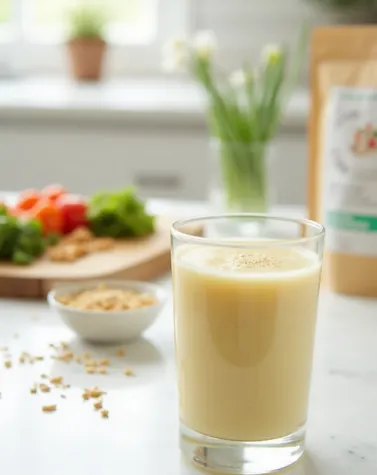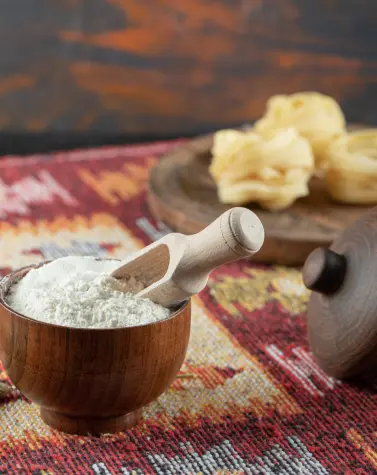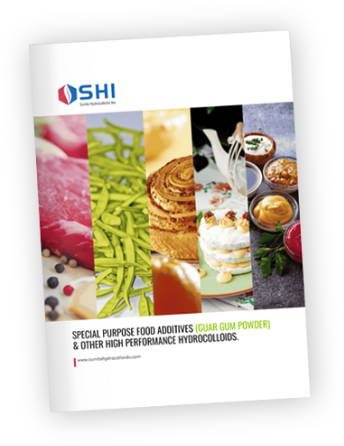
A Complete List Of Food Items That Include Gum
Ever wondered how your favorite ice cream stays so creamy or how that salad dressing emulsifies so perfectly? A peek at these packaged goods’ labels will disclose that the secret to the smooth texture and consistency you find is the result of food gum additives. The food industry utilizes edible gum in recipes to bind ingredients and lengthen shelf time.
This blog post offers a comprehensive guide on food gums and a detailed list of food items that commonly contain gums, highlighting the specific functionalities each gum provides and how they contribute to the final product you enjoy.
What are Food Gums?
Food gums or hydrocolloids are diverse substances added to foods to modify their texture, stability and other functional properties. Food engineers have been using them for decades to create the perfect mouthfeel, stable texture and extended shelf life of packaged goods.
Derived from natural sources like plants, seeds and even microorganisms, these versatile ingredients uniquely bind with water, and form solutions with high viscosity or gels.
Characteristics of food Gums
Food gums are long-chain polysaccharides (complex carbohydrates) food additive that, when dispersed in water, create a thickening or gelling effect. These are made by processing plant extracts or formed by microbial fermentation. They typically have little nutritional value but are used in food production for thickening, stabilizing, emulsifying and binding properties.
Because of their diverse functionalities, food gums are indispensable in modern food manufacturing. They allow food producers to create products with consistent quality, desirable textures, and extended shelf life, ultimately enhancing the consumer experience.
Items that include Food gum
1. Dairy Products
Food gums are utilized for creamy ice cream, smooth yogurt and consistent cheese spreads rely on gums like carrageenan, guar gum, and locust bean gum for their desirable mouthfeel and smooth textures. Gums prevent separation in milk products and stabilize them to keep them looking and tasting fresh for longer. Not only this, you get the mouth feel of fat-infused processed foods without getting the calories as in low-fat options, gums mimic the richness of fat, making healthier choices more appealing.
2. Baked Goods
Gums like xanthan gum and guar gum improve shelf life and dough elasticity, making it easier to work with and preventing crumbliness when making bakery processed food products such as bread, cakes and pastries. They also help retain moisture in baked goods, preventing staleness and keeping them soft for longer. These gums are predominantly used in gluten free baked goods to provide the structure and texture that gluten typically provides.
3. Beverages
Food gums thicken beverages and create a more satisfying mouthfeel. They prevent settling and separation in fruit juices, syrups, nut milk, flavored drinks and even alcoholic beverages. They also keep particles like pulp in suspension, ensuring a consistent product with a nice mouthfeel.
4. Meat & Poultry
Gums like carrageenan and guar gum help retain moisture in processed meats, improving its juiciness. They act as binders in formed meats and improve texture sliceability. They are also used as fat reducers in some meat products while rendering its creamy texture and still being a healthier option.
5. Confectionery
Food gums create desired textures in candies, from chewy gummies and marshmallows to smooth jellies. They prevent sugar crystals from forming in candies, keeping them smooth and preventing a gritty texture. They also control the release of flavors in candies, providing a longer-lasting and more enjoyable experience.
Contributing to gelling, textural variations from chewy to gummy and moisture retention, food gums make the confectionery taste yummy. For those of you wondering what foods is gum agar found in, it is used in confectionery items such as jellies due to its ability to form a stable gel even at low concentrations.
6. Sauces & Dressings
Gums like xanthan and guar gum thicken sauces and dressings (salad dressings, soups and sauces), creating a richer consistency. They also help blend oil and water in dressings, preventing separation and maintaining a stable product. Moreover, they modify the flow properties of sauces, making them easier to pour and use.
Benefits of Food Gums in Food Production
Food gum is a food additive that finds applications in various industries due to its versatility and benefits.
- Thickening Agent– They create a richer, fuller texture in sauces, soups and beverages.
- Gelling – They form a solid or semi-solid structure as seen in jams, jellies and desserts.
- Stabilizing – They prevent the separation of ingredients in emulsions like salad dressings and ice cream.
- Emulsifying -They help to blend oil and water and create a stable mixture.
- Binding – They help hold ingredients together as in processed meats and baked goods.
- Coating – They provide a protective layer or enhance the appearance of certain foods.
Health Benefits Of Food Gums
Food gums contain a high fiber content, which makes them conducive to maintaining digestive system health. They have benefits associated with improvements in stool texture and bowel movement frequency. Acting as a prebiotic, they promote the growth of good bacteria and reduce the harmful bacteria in the gut.
Understanding Food Gum Ingredients on Labels
There are different types of gums derived from various sources, majorly plant-based that you might see mentioned on the food labels of the packaged goods. Get to know these natural food gums and their origins to identify them and their role when you encounter them on the label.
- Guar Gum : It comes from guar beans and is contained in the endosperm, which is separated and ground into a powder used as guar gum.
- Xanthan Gum: It is produced by the fermentation of sugars (like glucose or sucrose) by the bacterium Xanthomonas campestris. The fermented sugar products are dried and ground into the xanthan gum powder.
- Locust Bean Gum: Or Carob bean gum is derived from the seeds of the carob tree (Ceratonia siliqua), a tree native to the Mediterranean region which is also known as locust tree. The seed is then processed to yield the locust bean gum used in various food applications.
- Gum Arabic: This tree exudate gum derived from the hardened sap of acacia trees, which are native to the arid regions of Africa. The gum is harvested by tapping the trees, allowing the sap to dry into nodules, which are then collected and processed.
- Agar Gum: Also known as Agar-agar, Agar gum is a gelatinous substance derived from red seaweed. The function of gum agar in food is to work as a gelling agent. It is utilized in products like jellies, puddings, desserts, vegan pastries and certain types of dairy-free yogurt.
Conclusion
Food gums may come from various sources but they have outdone themselves in revolutionising the food industry. Sunita Hydrocolloids Inc. (SHI) is the leading guar gum manufacturer and supplier that provides products of the highest quality, aligned with the industry standards. We know that food gums are extremely significant in the food industry with various applications which is why we offer premium guar gum solutions.
Related Articles
Explore more insights into food additives, thickeners, and guar gum applications:
FDA-Approved Food Thickeners – Understand the role of approved thickeners in food production and how they contribute to texture, stability, and shelf life.
Guar Gum in Cooking – Discover how guar gum enhances recipes—from thickening sauces to improving texture in gluten-free baking.
Is Guar Gum Gluten-Free? – Understand why guar gum is a popular choice in gluten-free diets and how it supports healthy, allergen-friendly food production.





